Select Language
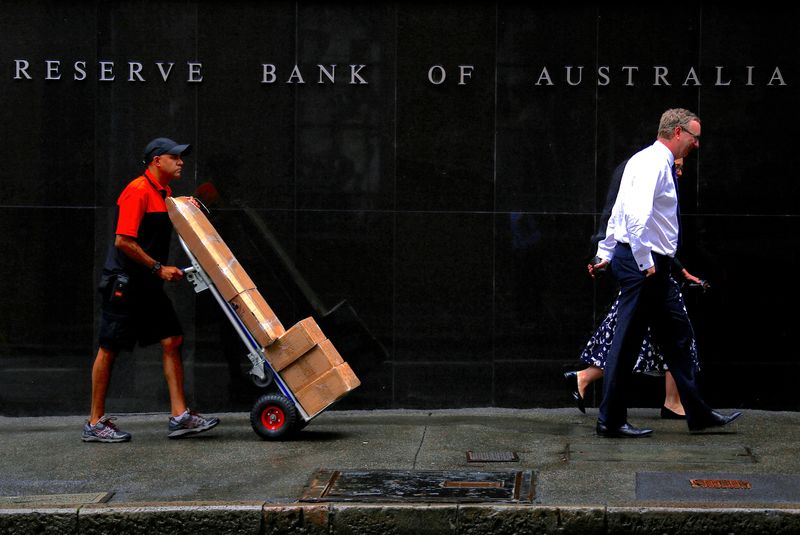
SYDNEY (Reuters) - Australia's central bank said on Wednesday that monetary policy was restrictive with the current cash rate causing financial pain for many households, but it could not rule out further tightening if necessary to tame inflation.
In a speech on the banking industry in Melbourne, Reserve Bank of Australia (RBA) Assistant Governor Christopher Kent said interest rates of 4.35% were contributing to slower growth of demand and lower inflation.
"We know that many are feeling a painful squeeze on their finances because of higher interest rates," said Kent, noting mortgage payment has already increased to a record 10% of household disposable income.
Kent said rates were clearly above all estimates of the neutral rate - that which neither stimulates nor retards economic growth.
The RBA has raised interest rates by a whopping 425 basis points since May 2022, but has held steady for five straight meetings with inflation running at 3.6%, well above its target band of 2-3%.
RBA Governor Michele Bullock earlier this month told reporters that the restrictive policy is one reason that the policymakers were reluctant to raise rates further at its June policy meeting.
Markets see only a modest chance of a rate cut until April next year, and just 43 basis points of easing has been priced in by the end of 2025.
Kent reiterated the central bank was in no rush to ease.
"While recent economic data have been mixed, they have reinforced the need to remain vigilant to upside risks to inflation," he reiterated.

(Reuters) - Uncertainty looms over the U.S. auto industry, fueled by expectations that the presidential elections in November will reshape the economy, affect interest rates or influence inflation levels, a report from Cox Automotive showed on Tuesday.
Cox forecast that new-vehicles sales volume in the first half of 2024 will rise by 2.9% year-over-year and held its full-year forecast steady at 15.7 million.
WHY IT'S IMPORTANT
Consumers in the U.S. have been reluctant to make big-ticket purchases like vehicles due to inflationary pressures. Shoppers may continue to hold back due to economic uncertainty stemming from the presidential election, the report says.
KEY QUOTES
"If shoppers believe interest rates will be lower in the future, or that the economy will be improving – or worsening – post-election, they are more likely to stay on the sidelines, waiting for the dust to settle," said Vanessa Ton, senior manager at Cox Automotive.
"There is a view from consumers now that if they wait, they're going to get a better price," Charlie Chesbrough, senior economist for Cox Automotive, said in a media briefing on Tuesday.
BY THE NUMBERSBoth shoppers and dealers believe that inflation is the top concern, with 74% of consumers and 81% of dealers believing the next election will influence it.
However, auto dealers are divided on the impact of the election on vehicle sales, with about 38% expecting sales to worsen, and 31% each who expect sales will either improve or remain the same.
WHAT'S NEXT
About 41% consumers believe that vehicle prices will rise due to the election, while 33% believe it will have no impact on prices, according to the report.

MUMBAI/BENGALURU (Reuters) -India's worsening water shortage, triggered by high consumption amid rapid economic growth and frequent natural disasters, can negatively impact the South Asian nation's sovereign credit strength, Moody's (NYSE:MCO) Ratings said on Tuesday.
Millions of Indians face water shortages every summer when water demand rises in farms, offices and homes against a limited supply, but a prolonged heatwave this year has worsened the shortfall, including in Delhi and the southern tech hub of Bengaluru.
"This is detrimental to the credit health of the sovereign, as well as sectors that heavily consume water, such as coal power generators and steel-makers," Moody's Ratings said in a note.
"In the long term, investment in water management can mitigate risks from potential water shortages," it added.
India's average annual water availability per capita is likely to drop to 1,367 cubic meters by 2031 from an already-low 1,486 cubic meters in 2021, according to the Ministry of Water Resources.
A level below 1,700 cubic meters indicates water stress, with 1,000 cubic meters being the threshold for water scarcity, according to the ministry.
"Decreases in water supply can disrupt agricultural production and industrial operations, resulting in inflation in food prices and declines in income for affected businesses and communities, while sparking social unrest," Moody's said.
This, in turn, can exacerbate volatility in India's growth, it warned.
Increases in the frequency of water shortage, severity or durations of extreme climate events stemming from climate change will exacerbate the situation because India heavily relies on monsoon rainfall for water supply, the global agency said.
Industrialisation and urbanisation will intensify competition for water among businesses and residents, it added.
The sustainable finance market in India can provide companies and regional governments with a critical avenue to raise funds, it said. Moody's currently has a Baa3 rating on India with a stable outlook.
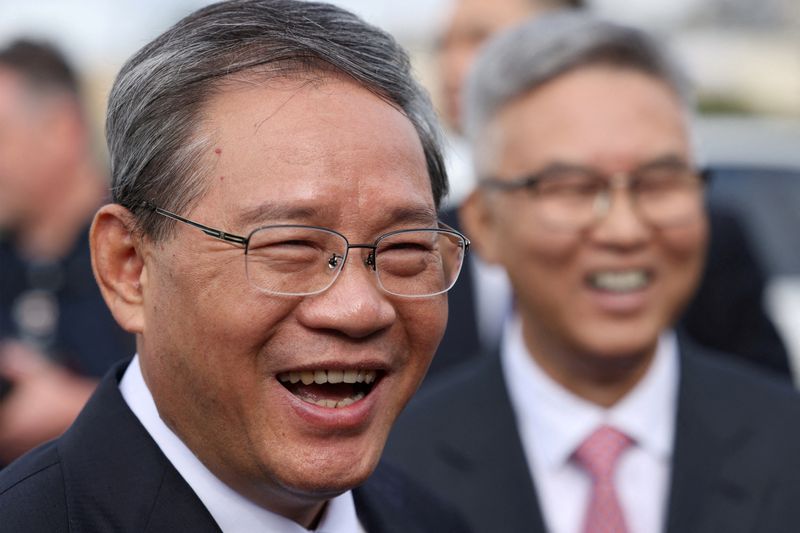
By Ellen Zhang and Joe Cash
DALIAN, China (Reuters) -China's Premier Li Qiang used his address at a World Economic Forum meeting in Dalian to hit back at accusations from the U.S. and EU that Chinese firms benefit from unfair subsidies and are poised to flood their markets with cheap green technologies.
Li's comments come as China and the European Union prepare to host technical talks on the planned imposition of tariffs on Chinese-made electric vehicles (EVs) imported into the 27-strong bloc and after the United States unveiled steep tariff hikes on an array of Chinese imports, including EV batteries, in May.
"China's production of advanced electric vehicles, lithium-ion batteries and photovoltaic products, etcetera, first met our domestic demand, but also enrich global supply," Li said in opening remarks in the northeastern Chinese city on Tuesday.
"The rapid rise of China's new industries is rooted in our own unique comparative advantages," Li added.
Brussels' trade policy has turned increasingly protective and aligned with that of Washington over concerns China's production-focused development model could see it flooded with cheap goods as Chinese firms look to step up exports amid weak domestic demand.
Beijing has warned Brussels it risks opening up a new front in the West's trade war with Beijing - which began with Washington's initial import tariffs in 2018 - and opened an anti-dumping probe into EU pork imports following the EU's tariff decision.
"The continuous emergence of economies of scale can effectively dilute enterprises' innovation costs... which is the real source of the strong competitiveness of China's new industries," Li said.
China maintains it simply decided to invest in green technologies earlier, and that the West's actions are unjustified.
"China's really made headway into producing these cars at low cost... so it is a lesson for us to try to get our act together and be better at it," said Benoit Boulet, professor of electrical and computer engineering at McGill University, on the summit's sidelines.
"It's seen as a threat at the very beginning, but then eventually Chinese cars will come to North America."
China and Chinese analysts have consistently rejected accusations it has an over-capacity problem or that its firms benefit from unfair subsidies, asserting that as the $18.6 trillion economy recovers, supply will better meet demand.
Li told delegates "the rapid growth of new industries and new driving forces has strongly supported and sustained the healthy development of China's economy."
"Since the beginning of this year, China's economy has maintained an upward trend... and is expected to continue to improve steadily over the second quarter," Li said.
"We are confident and capable of achieving the full-year economic growth target of around 5%," he added.

By Nate Raymond
(Reuters) -Two federal judges in Kansas and Missouri on Monday at the urging of several Republican-led states blocked President Joe Biden's administration from further implementing a new student debt relief plan that lowers payments.
U.S. District Judge Daniel Crabtree in Wichita, Kansas, blocked the U.S. Department of Education from implementing parts of a student loan repayment plan not already in effect that cuts borrowers' monthly payments and provides a faster path to have debts forgiven.
He ruled shortly before U.S. District Judge John Ross in St. Louis, Missouri, issued a preliminary injunction barring the department from granting further loan forgiveness under the administration's Saving on a Valuable Education (SAVE) Plan.
The SAVE plan provides more generous terms than past income-based repayment plans, lowering monthly payments for eligible borrowers and allowing those whose original principal balances were $12,000 or less to have their debt forgiven after 10 years.
Missouri Attorney General Andrew Bailey, a Republican who helped lead the litigation, hailed Ross' decision. "Congress never gave Biden the authority to saddle working Americans with half-a-trillion dollars in other people's debt," he wrote on social media platform X.
The White House said it strongly disagreed with the rulings and criticized Republican elected officials who have fought against student debt forgiveness.
"Today's rulings won't stop our administration from using every tool available to give students and borrowers the relief they need," White House Press Secretary Karine Jean-Pierre said in a statement.
Biden, a Democrat, announced the SAVE Plan in 2022, alongside a broader $430 billion program that would have fulfilled a campaign promise by cancelling up to $20,000 in debt for up to 43 million Americans. It was ultimately blocked by the conservative- majority U.S. Supreme Court in June 2023.
The SAVE Plan was slated to fully take effect on July 1, though parts of it already been implemented, with 414,000 borrowers by mid-May having been granted $5.5 billion in debt relief, according to the Education Department.
The White House has said that over 20 million borrowers could benefit from the SAVE Plan. The administration in May said that 8 million are already enrolled, including 4.6 million whose monthly payments have been reduced to $0.
Eleven states challenged the plan in a lawsuit in Kansas. Crabtree had recently dismissed eight of the states' claims, but allowed South Carolina, Texas and Alaska to push forward. Seven other states sued in Missouri.
Neither judge on Monday ordered any debt relief already granted unwound. Crabtree said the Republican-led states waited too long to sue to claim they were being irreparably harmed by the in-effect aspects of the SAVE Plan.
But Crabtree, who like Ross was appointed by Democratic former President Barack Obama, said the Higher Education Act of 1965 did not clearly authorize the type of "unprecedented and dramatic expansion" of income-based repayment plans envisioned.
He cited an estimate by lawyers for the Republican-led states of South Carolina, Texas and Alaska that the SAVE Plan would carry a price tag of $475 billion over 10 years.
Ross, ruling in favor of seven states led by Missouri, reached a similar conclusion in finding the department "overstepped its authority by promulgating a loan forgiveness provision as part of the SAVE program."
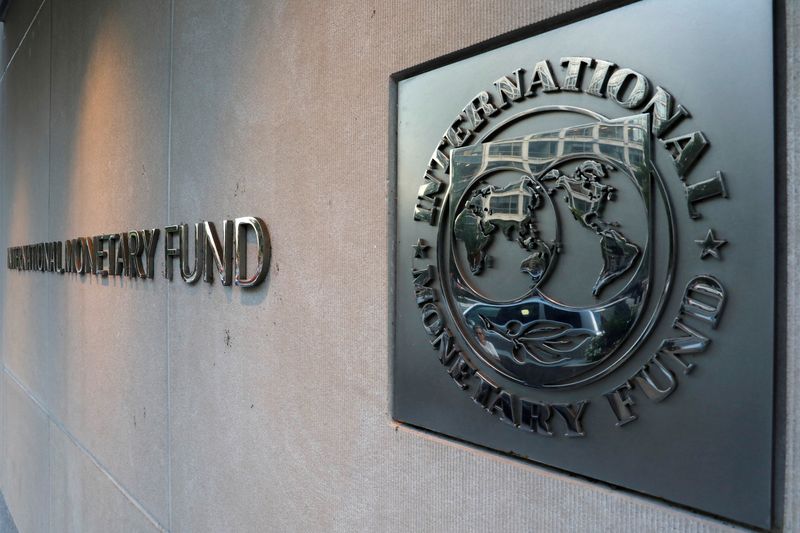
WASHINGTON (Reuters) - The International Monetary Fund said on Monday its Executive Board has concluded a second review of Bangladesh's bailout program, giving the country immediate access to about $928 million in loans for economic support and about $220 million to combat climate change.
"Bangladesh’s economy is navigating multiple macroeconomic challenges," IMF Deputy Managing Director Antoinette Sayeh said in a statement.
"Even in the difficult environment, program performance has been broadly on track and the authorities remain committed to undertaking the necessary policy actions and reforms," she said.
Bangladesh's $4.7 billion bailout was approved by the fund's Executive Board in January 2023.
The board's first review of the bailout plan was cleared in December and gave Bangladesh immediate access to about $468.3 million for its economy and about $221.5 million in support of its climate change agenda.

By David Shepardson
WASHINGTON (Reuters) - The U.S. Transportation Security Administration said it had screened 2.99 million airline passengers on Sunday, the highest-ever number in a single day.
The agency said on Monday it expects to screen more than 32 million travelers during the 2024 Independence Day travel period that runs from Thursday through July 8, which is 5.4% higher than 2023 levels.
The TSA said it expects on Friday it will for the first time screen more than 3 million people, the busiest day expected during the upcoming holiday period. Sunday's record broke the prior high of 2.95 million set in late May, while seven of the 10 busiest travel days ever have occurred over the past month.
A group representing major U.S. airlines forecast record summer travel with airlines expected to transport 271 million passengers, up 6.3% from last year.
Industry group Airlines for America said U.S carriers plan to fly more than 26,000 daily flights this summer, up nearly 1,400 or 5.6% over 2023, when they carried 255 million passengers. The summer travel season forecast is for June 1 to Aug. 31.
The forecast comes as the Federal Aviation Administration is struggling to address a persistent shortage of air traffic controllers. Some airlines voluntarily trimmed New York flights last summer to address congestion issues and have raised new concerns about the lack of controllers.
The FAA said on June 5 it would again extend cuts to minimum flight requirements at congested New York City-area airports through October 2025, citing shortages of air traffic control staff.
The FAA said the number of controllers handling traffic in New York is insufficient for normal traffic levels and that without "increased flexibility," congestion, delays, and cancellations are likely at JFK, LaGuardia and Newark airports.
Under minimum flight requirements, airlines can lose their takeoff and landing slots at congested airports if they do not use them at least 80% of the time. The FAA's waiver allows airlines to fly fewer flights and still retain slots.
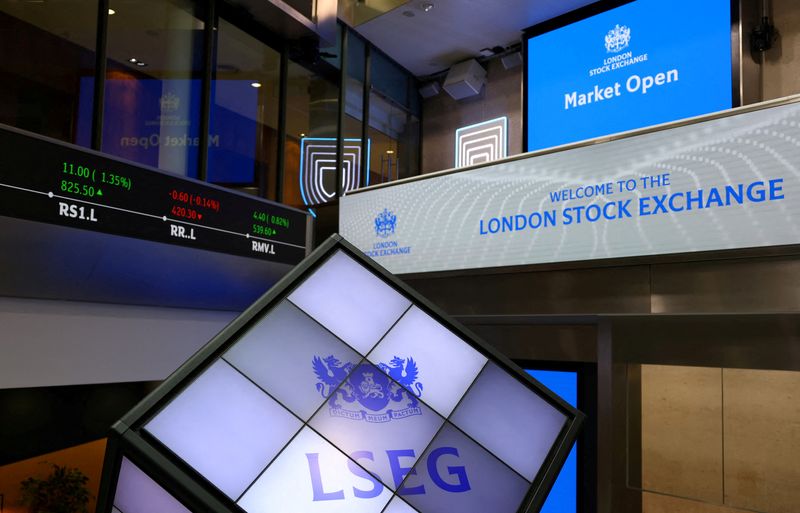
(Reuters) - London's FTSE 100 was flat on Monday as investors turned cautious ahead of key inflation data in the United States, while a downtick in oil and copper prices weighed.
The blue-chip FTSE 100 was unchanged after touching a two-week high on Friday, while the mid-cap FTSE 250 was off 0.1% at 0709 GMT.
The energy sector fell 0.3%, in tandem with oil prices, as concerns of higher-for-longer interest rates in the U.S. strengthened the dollar. [O/R]
Industrial miners slipped 0.7%, as concerns of muted Chinese demand kept traders on the sidelines, pulling down copper prices. [MET/L]
The Bank of England (BoE) kept interest rates unchanged on Thursday, with renewed hopes of an August rate cut after comments from policymakers.
A domestic inflation report last week showed that headline inflation in the economy had fallen to 2% - the BoE's target.
In the U.S., the personal consumption expenditure numbers (PCE) are due on Friday. Investors are banking on the data to show a renewed moderation in inflation.
Also due are the gross domestic product numbers in the UK, that will shed more light on the state of the British economy, after strong retail sales data on Friday tempered some optimism from the BoE's comments.
Prudential gained 4.6% after the insurance group said it planned a $2 billion share buyback programme, to be completed by mid-2026.
Shares of HG Group gained 4.7% after the ecommerce company agreed to sell its portfolio of luxury goods website to Fraser's Group for an undisclosed sum. Fraser's Group was up 0.9%.
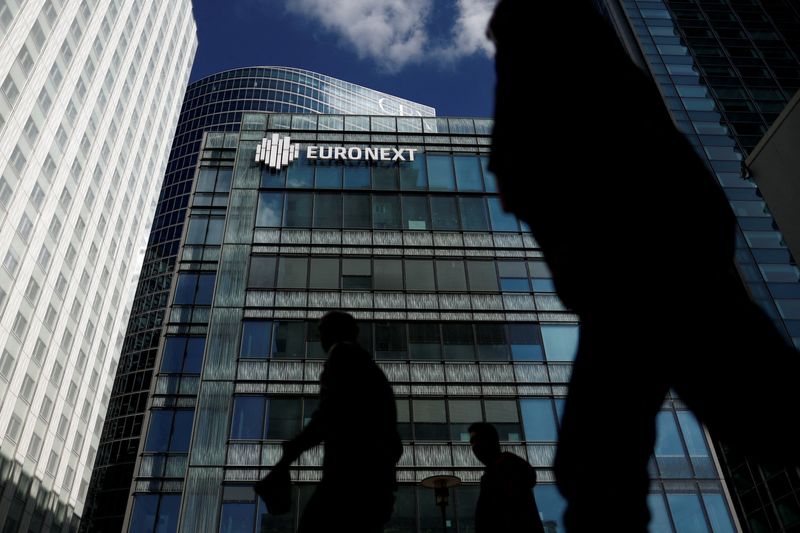
By Anousha Sakoui, Emma-Victoria Farr and Elisa Anzolin
LONDON (Reuters) -The European IPO market is unlikely to see any new candidates until after the summer, as political uncertainty has roiled markets, bankers said.
This week Italian luxury sneaker brand Golden Goose and Spanish fashion retailer Tendam both postponed planned listings citing the impact that France's snap election had on markets.
The election call last week in response to a drubbing in a European Union vote by the far right pushed down the euro while French blue-chip stocks dropped and bonds tumbled.
But several bankers stress the market is not closed for deals, as year to date share sale volumes have staged a recovery. In one example this week, frozen bakery goods company Europastry announced its intention to list in Spain and raise at least 225 million euros.
"I don't think the market is closed but clearly for an IPO market that was tentatively recovering it has been a bit of a knock," said Andreas Bernstorff, head of equity capital markets at BNP Paribas (OTC:BNPQY).
Even if there are fewer IPO candidates as political uncertainty continues, with some even shifting their plans to 2025, share sales in already listed companies will continue, bankers said. Block trades are still popular with investors with around $150 million shares in Johannesburg-listed Momentum Metropolitan sold this week.
"The recent volatility we have seen around French elections is more likely to affect continental European transactions which are sensitive to the macroeconomic environment, but equally there is a good debate in Europe around pro-growth policies which could benefit investor sentiment," said Alex Watkins, co-head of equity capital markets international at JP Morgan.
Share sales across Europe, Middle East and Africa year to date have reached $89.8 billion, up 45% from the same period last year, Dealogic data shows. That is still off the recent high of $168 billion for the same period in 2021.
The value of IPOs year to date stands at $19.5 billion, up 117% from the same period last year, with successful offerings from CVC, Galderma and Puig.
But the shock announcement of a parliamentary election in France which kicks off June 30 caused a spike in volatility and a sell-off in stocks. Last week the Euro STOXX 50 volatility index jumped to its highest level since October.
On Tuesday night Golden Goose, which makes $500 sneakers, and its owner buyout fund Permira, decided to pull an IPO it had announced at the end of May. The at least 508 million euro offering was thrown into doubt as shares of France's LVMH and another luxury peer Moncler sank.
Part of Permira's decision was uncertainty over the after-market, notably given the performance of another of its IPOs Dr Martens, people familiar with the matter said. The British bootmaker's shares are down 78% since its 2021 float. Permira declined to comment.
The summer is typically a quieter period for new issues and some bankers have been warning that investors are being selective about the deals they will back.
"There is a moderate pipeline post summer, but it won't be a bonanza," Watkins said. "The pipeline is building strongly for 2025 onwards."
Investors are concerned about the potential impact of the French elections and are worried about what a surge to the right politically will mean for the European Union, and for issues like Ukraine and fiscal policy, one equity capital markets banker said, speaking on condition of anonymity.
The U.S. elections in the autumn are also likely to have an impact on the timing of IPOs, but bankers believe investors are less concerned about the potential for market volatility. That could mean a better chance for those companies looking to list from September onwards.
"There are some IPOs that are lining themselves up to come after the summer and they might have a better shot than previously thought," Bernstorff said.
Companies including German academic publisher Springer Nature and drugmaker Stada could IPO later this year, Reuters reported recently.

BEIJING (Reuters) - China is gravely concerned and firmly opposed to U.S. proposed rules for curbing certain investments in China, and reserves the right to take corresponding measures, the Chinese commerce ministry said on Monday.
The U.S. should "stop politicising and weaponising economic and trade issues, and lift investment restrictions on China," the ministry said in a statement.
Washington issued on Friday draft rules for banning or requiring notification of certain investments in artificial intelligence and other technology sectors in China that could threaten U.S. national security.

